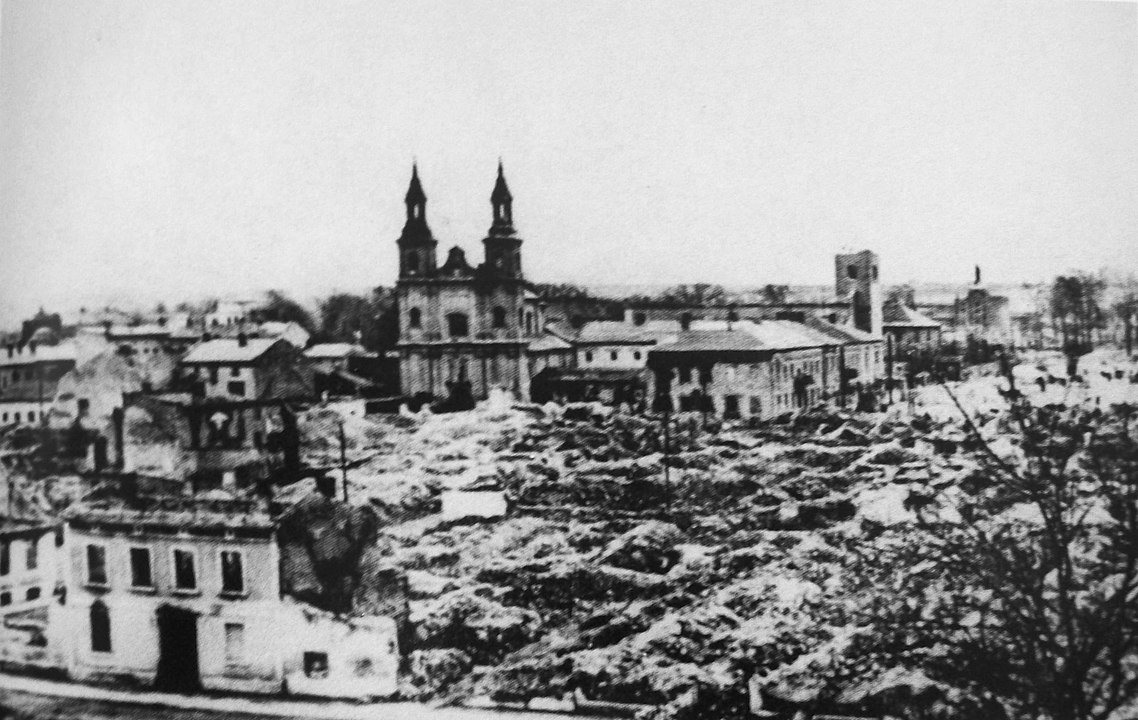In the early hours of Friday morning, 1 September 1939, the German battleship Schleswig – Holstein fired first bullets at the Polish garrison located at the Westerplatte peninsula. The attack and the following Polish fierce resistance constituted what is now considered to be the first battle of the Second World War. But other acts of war unrolled almost simultaneously also in other parts of Poland – including the “Polish Guernica” or the air raid on Wieluń, the first attack of the Second World War involving civilian casualties.
In the interwar period, the Polish town of Wieluń lied about 20 km from the border with the Third Reich and was inhabited by around 16 000 people, including a sizable Jewish minority. With its brewery, two mills, bakery, power plant, brickyard, sawmills and sugar factory at the outskirts of the city, Wieluń had neither industrial nor strategically relevant investments. It resembled many other Polish rural municipalities relying on agriculture, craft and trade.
The peaceful existence of the town was brutally interrupted during the early hours of 1 September 1939. “I was woken up by the roar of sirens and the roar of planes. I didn't know what it was. I sat on the bed and asked my mother what is [going on]. My mother said: You know, baby, it's probably a test, but you better dress up”1 – recalls Zofia Burchacińska who in 1939 was 11 years old and remains one of the last living eyewitnesses of the bombing. Her account can be seen in the documentary Wieluń. 13 cegieł [Wieluń. 13 bricks], along with that of Eugeniusz Kołodziejczyk, 12 years old at the time, who remembers calling: Dad, Dad! I can see the planes! Dad, Dad, bombs are falling while drawing lines on the sky. “[That’s when] the roar started. Hell had begun”2.
One of the first bombs was dropped on the hospital visibly marked with a Red Cross sign. The raid lasted from the early morning until 2 pm. During that time 70% of the city was destroyed, including the synagogue, church and innumerable residential buildings. Between 700 to 2000 civilians were killed – the first civilian casualties of the Second World War (the exact number is unknown due to difficulties with identification).
The precise time of the bombing remains a topic of discussion. According to the accounts of the town’s inhabitants and of the Polish border guards, the first bombs fell at 4:40 am – five minutes before the first shots on Westerplatte. This would make the attack on Wieluń the beginning of the Second World War. The Luftwaffe documents and several other testimonies, however, indicate 5:40 am as the time when the air raid started. Some historians attribute this discrepancy to a summer time-difference between Poland and Germany (whose occurrence in itself is also being debated); others point to possible mistakes in witness accounts.
The rationale for choosing Wieluń for the attack is also an assumption for speculation. Since almost no strategically important sites were located within the town, some researches claim that the air ride was supposed to constitute a safe “real life test” for the Luftwaffe new dive bombers. Others note that the German army might have wanted to destroy the town’s train station and the nearby railroad tracks situated relatively close to the German-Polish border. Nevertheless, due to the sheer magnitude of the attack, many suspect that the main goal of the bombing might have been psychological – to create chaos and panic among the civilians and to diminish morale within the Polish Army.
Despite the aforementioned debates, Wieluń remains the first assault involving civilian casualties of the Second World War, and many see it as a symbol of Polish suffering during the war. As such, it is being compared to Guernica – a town destroyed in 1937 during the Spanish Civil War, no less but by the same Luftwaffe forces under the command of the field marshal Wolfram Freiherr von Richthofen.
1. Polish original: Rano obudził mnie ryk syren i ryk samolotów. Nie wiedziałam co to jest. Usiadłam na łóżku i spytałam mama co to. Mama powiedziała wiesz dziecko to chyba próby alarm ale lepiej się ubierz; at 10 min 50 sec: Wieluń. 13 cegieł, dir. Sławomir Górski, 2009
2. Polish original: Tata Tata, widzę samoloty, Tata tata bomby lecą. Zrobił się huk, zrobiło się piekło; at 14 min 58 sec: Wieluń. 13 cegieł, dir. Sławomir Górski, 2009
Bibliography:
Tadeusz Olejnik, Wieluń. Dzieje miasta 1793-1945, part II, Łódź-Wieluń, 2008
Tadeusz Olejnik, Wieluńska hekatomba. Początek wojny totalnej, Wieluń 2014
Wieluń był pierwszy. Bombardowania lotnicze miast regionu łódzkiego we wrześniu 1939 r., ed. Janusz Wróbel, Łódź 2009
Wieluń. 13 cegieł, dir. Sławomir Górski, 2009
